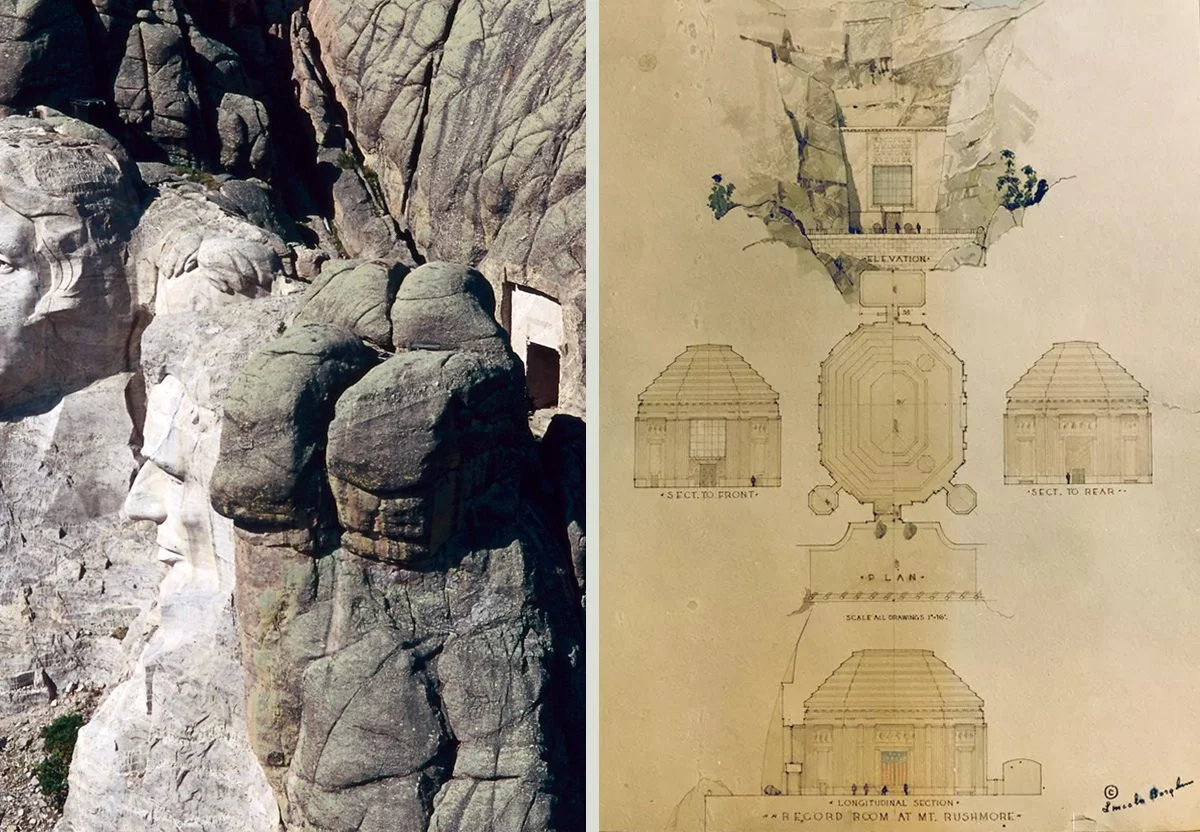The Mount Rushmore National Memorial is a colossal sculpture carved into the granite face of Mount Rushmore, featuring the figures of George Washington, Thomas Jefferson, Theodore Roosevelt and Abraham Lincoln.
Located in the Black Hills near Keystone, South Dakota, United States, the concept for the Mount Rushmore National Memorial was first devised in 1923 by American historian Jonah LeRoy “Doane” Robinson, with the intention of promoting tourism to the region.
The Black Hills had historically been located within the tribal territory of the Lakota, or Lakota Sioux, who called them Pahá Sápa, meaning “the heart of everything that is.” In 1868, the U.S. Government signed the Fort Laramie Treaty of 1868, which established the Great Sioux Reservation within all of present-day western South Dakota (including the Black Hills) and modern Boyd County, Nebraska.
However, the discovery of gold in 1874 as a result of George Armstrong Custer’s Black Hills Expedition, led to a gold rush that encroached on Lakota tribal lands. This ignited the Black Hills War of 1876, also known as the Great Sioux War, the last major Indian War on the Great Plains. Following the defeat of an alliance between the Lakota and Northern Cheyenne, the U.S. Government forcibly relocated the Lakota to smaller reservations in South Dakota.
A large gold and silver mining industry grew up that led to the growth of several major towns, however, as the economy of the Black Hills shifted away from natural resources, tourism and hospitality became the new drive for bringing income into the region.
Jonah LeRoy “Doane” Robinson introduced a bill to the South Dakota State legislature, asking for permission and funds for a massive carvings project. The original plan for the sculpture was to include the Sioux Nation chief, as well as several famous South Dakotans.
In 1924, Robinson met with the sculptor, John Gutzon de la Mothe Borglum, and together they scouted possible locations for their monument. The site they agreed on in collaboration with tribal representatives was called “The Six Grandfathers” by the Lakota, or Cougar Mountain, Sugarloaf Mountain, Slaughterhouse Mountain and Keystone Cliffs by American settlers.
It wasn’t until 1930 that the mountain would be recognised as Mount Rushmore by the United States Board of Geographic Names, following a generous donation by businessman, Charles E. Rushmore, towards the sculpture project.
Construction began in 1927, involving 400 workers under the direction of Borglum, Bill Tallman, Luigi Del Bianco, and later his son, Lincoln Borglum.
Borglum decided that the monument would feature 60-foot-high (18 m) carvings of George Washington, Thomas Jefferson, Theodore Roosevelt, and Abraham Lincoln.
By 1934, Washington’s face had been completed and was dedicated. The face of Thomas Jefferson was dedicated in 1936, the face of Abraham Lincoln in 1937, and the face of Theodore Roosevelt in 1939. A bill had been introduced to Congress to include the face of civil rights leader, Susan B. Anthony, however, a rider provision was instructed that only allowed federal funds to be used on sculptures that had already been started.
Borglum also planned to construct a large chamber known as the Hall of Records within the mountain, to house documents and artefacts most central to American democratic history.

The hall would be accessed via an 800-foot granite staircase, which led to a portal located behind the president’s faces. Above the entrance, the plan was to place a bronze eagle with a wingspread of 38 feet, inscribed with words over the eagle reading: “America’s Onward March” and “The Hall of Records.”
Surviving architectural drawings shows that Borglum planned for the recesses inside the hall to hold bronze and glass cabinets, containing historical documents such as the Constitution and the Declaration of Independence. The hall would also house busts of famous Americans, and a list of noteworthy Americans that made contributions to science, industry and the arts.
Construction of the Hall of Records started in 1938, with a 70-foot tunnel being blasted into the mountain using dynamite. Work was halted a year later when Congress instructed that works should only focus on completing the president’s faces.
Borglum died of a heart attack in 1941, having never seen work recommence on his Hall of Records. Following America’s involvement in World War II, all work on the Mount Rushmore National Memorial ended on October 31, 1941.
In 1998, his dream was completed, when a repository of records contained in a titanium vault and covered by a granite capstone was placed in the floor of the hall entry.
The repository contains panels that explain the story of how Mount Rushmore came to be carved and by who, a short history of the United States and reasons for selecting the four presidents depicted on the mountain.
Etched on the granite capstone is a quote by Borglum:
“…let us place there, carved high, as close to heaven as we can, the words of our leaders, their faces, to show posterity what manner of men they were. Then breathe a prayer that these records will endure until the wind and rain alone shall wear them away.”
Header Image Credit : John D Smith – Shutterstock





